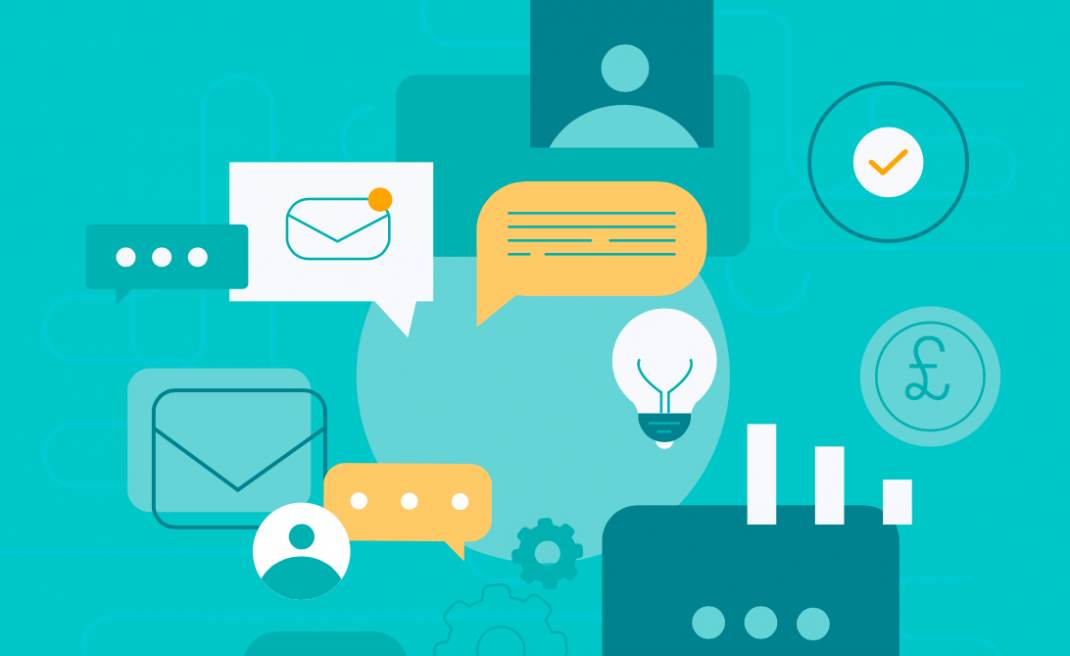The guests and vendors have headed home and you’ve taken down the branded signs – so now it’s time to send out your thank you for attendance email.
Follow-up emails are a tried and tested way to improve attendee engagement, gather feedback and promote future events. Check out this guide to learn our top tips for crafting your email, from the perfect subject line to the sign-off. We cover everything from structure to making the most of personalisation.
Use our post-event email templates to get things started, or create your own to suit your brand and attendee profile.
Table of Contents
Why send follow up emails after events?
10 best practices for how to write a follow up email
7 event follow up email example templates

Why send follow up emails after events?
Sending out a post-event message to attendees comes with a whole range of benefits, including:
1. Building relationships: Saying thank you is a simple yet effective way to show attendees and stakeholders that you value their time and involvement. It helps to build and strengthen relationships, which can increase engagement, build loyalty and create future opportunities.
2. Gathering feedback: Follow-up emails are a great way to gather feedback. Use them to improve future events and make sure that attendees’ needs are met.
3. Encourage repeat attendance: By sending a thoughtful message, you can encourage participants to return to your next event, which is important for building a long-term audience and generating repeat business.
4. Maintaining a positive image: A well-crafted email can help to maintain a positive image for your organisation and promote your brand. It can also help to leave a lasting impression on attendees, which can lead to positive word-of-mouth and increased visibility.
5. Keeping the conversation going: Your email is a great way to keep the conversation going after the event and to continue building relationships with attendees and stakeholders. Additionally, it can be used as an opportunity to share additional information and resources or to encourage attendees to stay engaged with your organisation.
6. Measuring the success: Your follow-up message can help you to measure the success of the event and gather feedback. The feedback and engagement data you collect can help you to evaluate the success of the event, identify areas that need improvement and make data-driven decisions in the future.

10 best practices for how to write a follow up email
Writing an email may sound simple, but a thoughtful and optimised email can leave people with a good feeling about your event — it could even lead to potential customers! After analyzing several post-event follow-ups from our creators, we’ve put together a list of best practices to help you create yours!
1. Plan your email in advance
Although your attendees won’t receive your post-event follow-up email until after they leave, drafting it beforehand can save you time on the day.
- Plan when to send it out: Send the email as soon as possible after the event, when it’s still fresh in attendees’ minds. Time it so that it arrives when they’re home – for evening events, an email arriving early the next morning can work well.
- Think about your call to action: What do you want your attendees to do afterward? Ask them to fill out a feedback survey, encourage them to post on social media with your event hashtag or invite them to book future events.
- Link to additional resources: If there’s anything relevant that relates to your event or future events, send it over to attendees as part of your post-event email.
2. Structure your email
- Start with a personalised greeting: Address each recipient by name and, if relevant, refer to their specific actions or engagement during the event.
- Summarise the event: Call back to key moments during the event and highlight any specific takeaways. Express appreciation for your attendees’ overall attendance and their support throughout the event.
- Add follow-up information: Invite your attendees to any upcoming events or opportunities for future engagement such as webinars, networking functions, or events in a similar area. For example, “Stay in touch by attending our networking event next month”.
- Share photos or videos from the event: Add any photos or videos from the event to give attendees a chance to relive the experience and to share it with others who weren’t there. For example, “Check out some of our favourite moments from the evening”.
- Include contact information: Let attendees know how to get in touch with you if they have any questions or feedback. Link to your website or social media so they know where to find out more if they’re interested in future events. For example, “We’d love to hear from you. Get in touch via email or phone”.
- Close with a thank you: Round out the email with a closing thank you that expresses appreciation for the attendees’ support.
- End with a clear, well-designed email signature: Include your company’s logo and contact information.
For more examples of how to structure your email, check out our purpose-built email templates for events, including templates for communicating with attendees.

3. Include a clear and compelling subject line
- Keep it short: If the subject line is too long, some of it may be cut off (especially if the recipient is viewing emails on their phone).
- Hint at what’s inside: Use the subject line to show the recipient why they should open up the email and find out more.
- Consider using personalisation: Grab your recipient’s attention with a name-specific subject such as “Thank you [attendee name], for being a part of [Event]”.
Examples of winning email subject lines
The subject line is the first part of your follow-up email that your attendees will see, so it’s vital that it grabs their attention and encourages them to read on.
Check out some of our favourite subject lines for thank-you emails:
- Thank you for being a part of [Event Name]!
- [Event Name] was a success thanks to you!
- Your presence was appreciated at [Event Name]
- Thank you for making [Event Name] a memorable experience
- We couldn’t have done it without you! [Event Name] wrap-up
- [Event Name] was a blast, thanks for being there!
- [Event Name] was a huge success, thanks to attendees like you!
- [Event Name]: A wrap-up and a big thank you
- [Event Name] was a huge success, thank you for your support!
4. What to include in your thank you email
When it comes to writing the content, there are some key areas to cover:
- Express gratitude towards your attendees for making the event possible. Think about how you want to say thank you for their attendance. Whether they were chipping into a debate, hosting a stand at an exhibition, or screaming along in the crowd at a concert, events just wouldn’t be the same without them – so be sure to let them know that.
- Highlight any key takeaways from the event. Did your attendees make new connections or discover new business opportunities at your event? Did they hear music from a new album, try food from a new vendor or hear a reading from a new book? Did they help contribute to a charity or disaster relief fund? Remind your attendees of the event’s key message or purpose.
- Keep the conversation going. Invite attendees to reflect on the event and share their thoughts via a feedback survey or post their pictures on social media. Direct them towards future events that they might want to get involved with.
Take a look at our post-event email sample below for some inspiration, or check out our other event email copy templates for more examples.

5. Ace formatting and design
Just like all of your event marketing, your email needs to be well-designed and aligned with your brand. We recommend keeping it fairly simple so that readers are guaranteed to get all of the key messages you’re sending them.
- Choose a clear, readable font and keep it the same size throughout so that attendees aren’t distracted by sudden changes
- Break up longer paragraphs to avoid big blocks of text
- Use images and graphics sparingly to show off the event
- Don’t make your email overly long or hard to read on a phone
Once you’ve put a first draft together, test your email on a few different devices to make sure it looks the way you hope. If you’re using merge tags or dynamic content, set up some practice runs to make sure they work properly before sending it out.
6. Ask for feedback
You will want to know what people thought of your event in order to improve it the next time around, so why not ask people for their honest feedback?
This can be in the form of a separate survey email or as a part of the thank you for coming email that you send. Either way, be sure to keep the feedback organized so that you can use it to inform future events.
7. Keep it personal
Personalising your emails lets attendees know you value them specifically. How best to do this depends on your event and your attendees.
- Use merge tags to automatically insert personal information into the email from the contact list. This is great for addressing attendees by name at the start of the email or in the subject line.
- Split up your email list according to key attendee features. That way, you can email each group based on their interests or actions taken during the event. For example, you could thank anyone who ran a stand at an exhibition for their role, while separately thanking standard-entry attendees for coming along and taking an interest in the stands.
- Using dynamic content allows you to show different content to different recipients.
- Consider using a friendly, conversational tone to make attendees feel cared for.

8. Remember GDPR
GDPR means you need to be extra careful about how you email people and store their information. Here are three important things to keep in mind:
- If event attendees didn’t opt-in to receive communications from you, then you can’t email them to say thank you – so even if they gave you their business card, you can’t just add them to your mailing list. You can, however, contact them and ask if they’d like to sign up to receive emails.
- It’s important to use BCC instead of CC when you send the email to keep everyone’s email addresses private.
- If you’re intending to use data – such as email open rates – to plan your future email campaigns, then you need to inform the recipients. An example might be sending different types of content based on what a person has previously read. Since you’re monitoring their behaviour, you will need to give people the option to unsubscribe from your mailing list.
9. Continue the conversation
Keep a follow-up email template to hand so that you can send it out while it’s still fresh in attendees’ minds.
A thank you email is the perfect place to find out what your attendees liked about the event and where there’s room for improvement. To gather feedback from attendees, use a tool like SurveyMonkey.
With 15 different survey question types to choose from, you can create a customised survey or use a pre-designed template to help you ask the right questions and receive the most useful responses.
Once you’ve built a quick questionnaire, encourage people to fill it out by offering a prize draw to respondents.
As well as asking for feedback, build rapport with your attendees by staying in touch with them and inviting them to future events.
- Use social media to continue the conversation and share content related to the event. Encourage attendees to share their own photos and experiences, and respond to comments and questions.
- Host a webinar or online event to provide additional value to attendees.
- Create a community for attendees where they can connect with each other and continue the conversation.
- Invite attendees to exclusive events such as networking events, meet-ups or roundtable discussions.
- Keep in touch with attendees by sending regular updates and relevant content via email or other communication channels.
10. Conclude with a clear CTA
Round out your email by inviting attendees to give you feedback, stay in touch, or book their next event.
If there is already a new event in the works, be sure to include your event invite. If there isn’t, let them know when they can expect to see dates.

7 event follow up email example templates
Now that you know how to create the perfect thank you for coming email, here are several follow up templates for every aspect. From the standard ‘thanks for coming’ outreach, to letting someone know it was great meeting them after a corporate event. We’ve even included post-event survey and thanks to the team emails. You can find them all below!
Thanks for attending an event
Subject: Thank you for attending [Event Name]
Dear [Attendee Name],
I wanted to take a moment to personally thank you for attending [Event Name] on [Event Date]. Your presence and participation helped make the event a success and we truly appreciate your support.
I hope you found the [event’s main topic/speaker/panel] as informative and engaging as we did. We received a lot of positive feedback and we’re glad you were able to take away valuable insights from the event.
We value your feedback. If you have a moment, please take our survey so we can improve our next events. [Include link to survey if applicable]
We’d love to see your photos or videos from [Event name]. If you’re posting them on social media, please include the hashtag #[Event hashtag] so we can check them out.
We hope you enjoyed the event and look forward to seeing you at our next one. If you have any suggestions or questions, please feel free to reach out to us. [Include contact details]
Thank you again for your support and we hope to see you soon.
Best regards,
[Your Name]
Follow up email after a meeting or corporate event
Hi [Name],
I wanted to say how much I enjoyed meeting with you at the [Company Name] [Event Name] on [Date]. I appreciated you sharing your thoughts and opinions on [event’s main topic/speaker/panel].
For your convenience, I’ve attached my notes on [Topic]. I’d be interested in talking with you more about this and the possibility of working together.
Please let me know when it would be convenient for you to meet so we can continue the conversation with a phone call. You can find a link to my calendar and LinkedIn below.
I look forward to our next conversation.
All the best,
[Your Name]
Thanks for attending a virtual event
Hi [First Name],
Thank you for attending our event, [Event Title]. I realize that your time is valuable, and I’m happy you took the time to join us.
I wanted to let you know that a replay is now available, and we’ve also added some helpful resources to keep the event going.
CTA: Access [Event Title] now
If you haven’t had a chance to watch it, please do! We’d love to hear what you think. Your feedback is incredibly helpful.
See you next time!
[Your Name]
Thank you to a guest speaker
Dear [Speaker Name],
I hope you’re having a great week so far!
I just wanted to follow up and express my sincere gratitude for your participation as a guest speaker at [Event Title]. Your presentation was [customize with genuine compliment]. It was clear that you put a lot of thought and preparation into your talk, and it showed.
I received so much positive feedback from attendees about you. People were particularly impressed with [custom]. I’m sure that the knowledge you shared at [Event Title] will positively impact attendees in many ways.
Thanks again for your participation. We hope to have you back as a speaker in the future!
All the best,
[Your Name]
Thank you for being an event sponsor
Dear [Sponsor Name],
I hope you’re doing well after [Event Name].
I just wanted to follow up and express my sincere gratitude for your sponsorship. Your contribution was essential to the success of the event, and we are all very thankful for your support.
[Event Name] was a resounding success, and it was clear that our attendees enjoyed engaging with [custom]. We received so much positive feedback about [list of things attendees commented on].
We are so very proud to have you as a partner, and we look forward to working with you in the future.
Thanks again,
[Your Name]
Thank you to your event team
Dear [Event Name] Team,
I hope you’re all feeling great about such a successful event!
I’m writing to express my sincere gratitude for all your hard work in making [Event Name] go off without a hitch. We worked hard, and it paid off. [Custom heartfelt thanks for concrete outcome].
I was particularly impressed with [list of things you appreciated about the event]. I also appreciated the opportunity to get to know each and every one of you.
Thanks again for all your hard work. I’m already looking forward to our next event!
All the best,
[Your Name]
Post-event attendee survey
Hi [Attendee Name],
I hope you had a great time at [Event Name]! We’re thrilled you could join us.
We would love to hear what you thought of the event! Please take a few minutes to complete our post-event survey. Your feedback is important to help us improve future events.
CTA: Take the Survey
Thanks so much for your time.
All the best,
[Your Name]
Now that you know how to write a follow up email for events that is impactful and genuine, you are well on your way to throwing your next event. Remember that Eventbrite has everything you need to create an outstanding event. Going beyond event ticketing, the platform has advanced marketing capabilities, reporting and analytics, and even a handy organiser app.
Create, market, and reflect on great events with Eventbrite’s organiser tools today.






